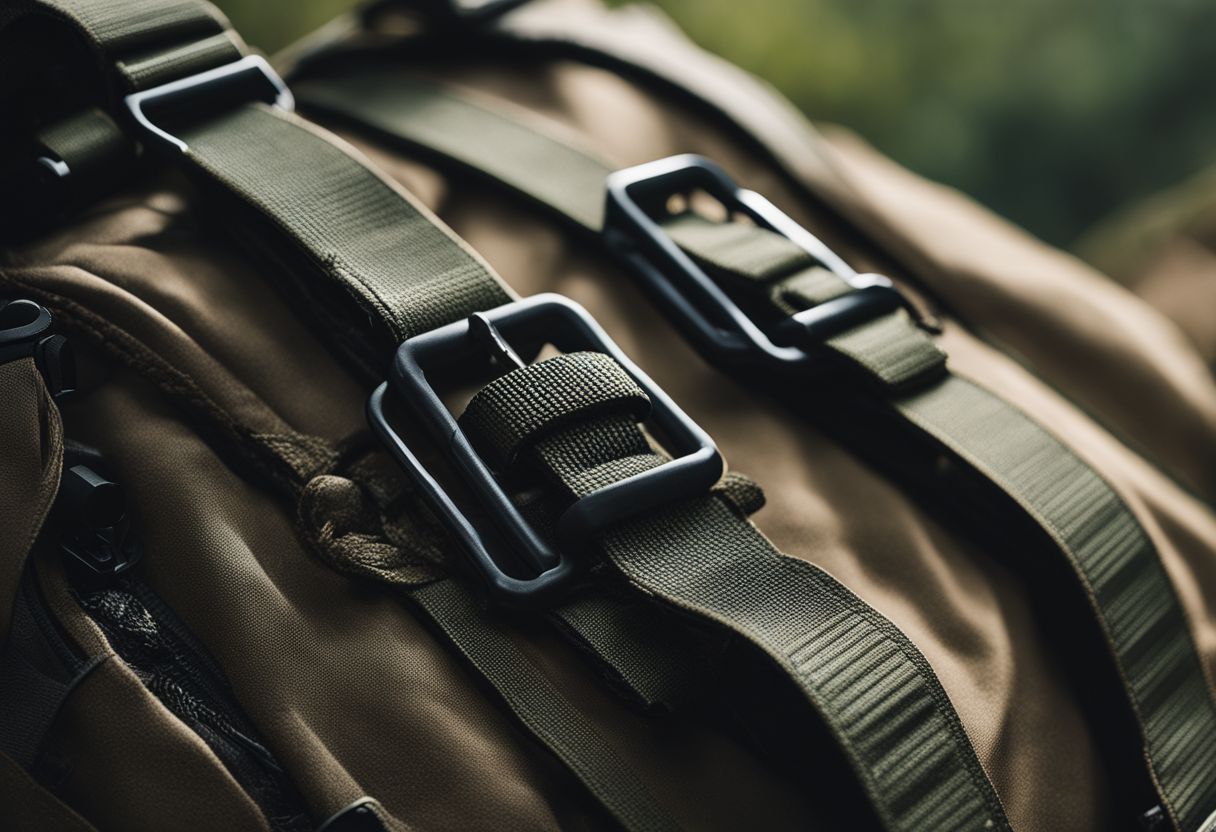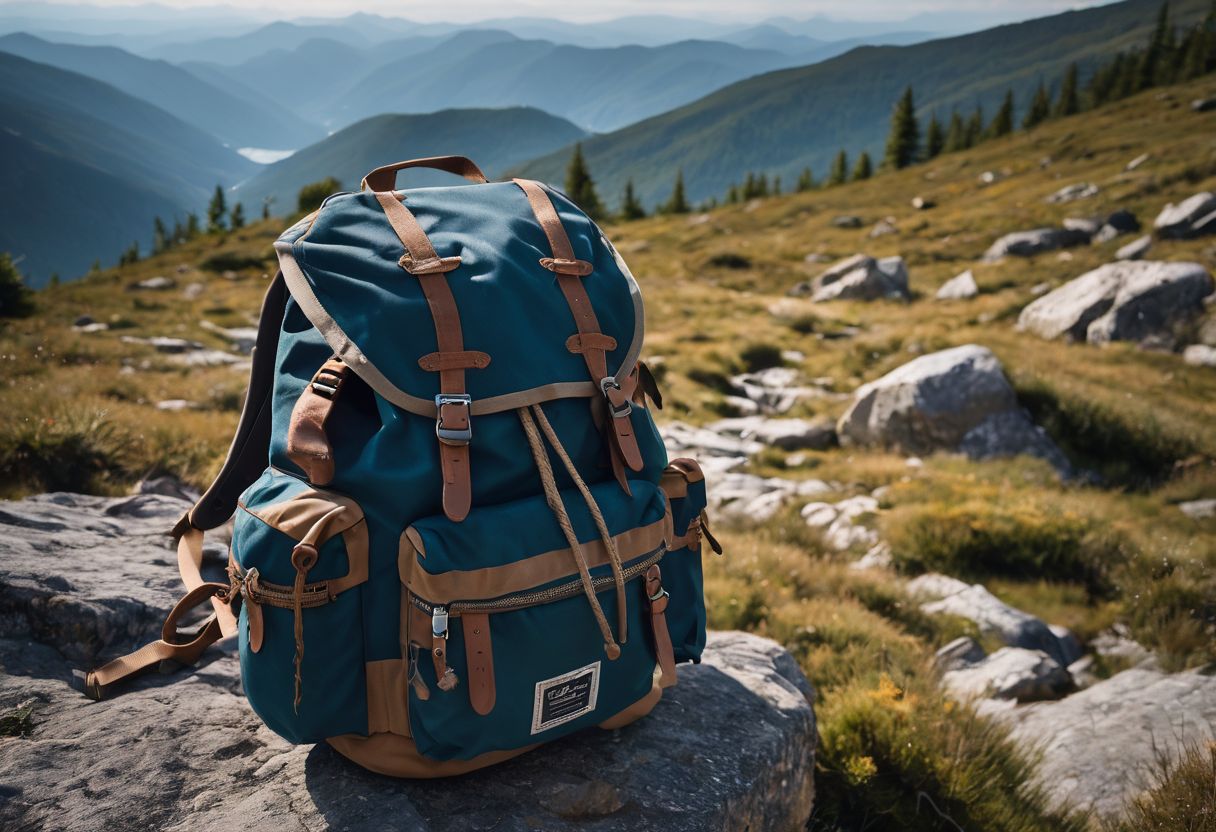Embarking on outdoor adventures with a trusty rucksack can lead to wear and tear that few are prepared for. It’s essential to understand how reinforcing your backpack can extend its lifespan and save you from the inconvenience of mid-journey equipment failures.
With years of experience in outdoor gear repair, I’ve seen firsthand the difference between a well-maintained pack and one that has been neglected — knowledge which I am eager to share with fellow adventurers seeking practical solutions.
Reinforcing straps and handles not only saves money in the long run but also ensures safety during your travels, be it hiking through rugged trails or navigating busy city streets.
Did you know carrying a backpack heavier than 10% of your body weight invites strain and potential injury? This article dives into simple yet powerful techniques to fortify your backpack against such risks.
Keep reading for insights that will equip you for many more miles; let’s strengthen those seams!
Key Takeaways
- Understanding the various types of backpack straps, like adjustable, padded, and ergonomic designs, is crucial for choosing durable materials such as nylon and reinforced stitching for long-lasting support during outdoor activities.
- Assessing damage in backpack straps — including visible signs of wear and tear, weight distribution evaluation, acromion angle measurement, overall ergonomics assessment — enables effective reinforcement planning tailored to individual needs.
- Techniques like maintaining padded straps using closed-cell foam and fabric glue fixes, advanced repairs with heavy-duty fabric patches or hardware replacement , customizing for comfort by adding extra padding and installing sternum straps contribute to extending the lifespan of backpack straps. Reinforcing stitching with heavy-duty thread and bar-tack stitching is vital for durability. Testing durability stresses their effectiveness over time.
Understanding Backpack Straps

Backpack straps come in various types, including padded, adjustable, and ergonomic designs. Durability is crucial, so consider materials like nylon or reinforced stitching for long-lasting support during outdoor activities.
Keep an eye out for signs of wear and tear to address them promptly.
Types of Backpack Straps
Backpacks come with different straps to help carry weight. These straps make sure the backpack fits well and feels comfortable.
- Adjustable shoulder straps: These can change length to fit your body just right. You can make them longer or shorter so that the backpack sits on your back in a comfy way.
- Padded shoulder straps: They have soft material inside to stop the straps from digging into your shoulders. This padding helps when you’re carrying heavy things, making it easier on your body.
- Chest straps: Also known as sternum straps, they go across your chest to hold the shoulder straps in place. This helps spread out the load and keeps the bag stable while you move around.
- Customizable straps: Some backpacks have these so you can take off old straps and put on new ones. You might want different types for different trips or if a strap breaks.
- Ergonomic straps: They are shaped to fit your body better. S-curved and J-curved are two types that follow the natural curve of your shoulders, helping to reduce strain.
- Detachable harness: This means you can take off the whole set of shoulder and chest straps from your backpack. It’s useful when you need to wash them or swap them with others.
- Supportive straps: These give extra strength where it’s needed so that heavy loads don’t hurt your back or shoulders as much.
- Weight distribution straps: Such as stabilizer straps, they help by pulling the weight forward and making the backpack feel lighter on your shoulders.
- Loadbearing straps: These are super strong because they’re meant to carry lots of weight without breaking.
Material Considerations for Durability
Choosing the right materials for your backpack straps is key to making them last. Tough fabrics like Nylon, especially if they have a polyurethane or PVC coating, stand up well to heavy use.
Polyester pack cloth and military-grade Cordura are also great choices that can take a lot of wear and tear. It’s not just about strength, though – comfort matters too. Straps made with webbing, spacer mesh, or foams such as neoprene help spread out the weight you carry and let air flow to keep you cool.
For really durable straps, it’s smart to look at how they’re put together. Durable stitching techniques make sure your straps stay strong even when carrying heavy loads. Also, the material composition plays a big role in how long your backpack will last without wearing out.
Stick with materials known for toughness and get ready for all sorts of adventures without worrying about your gear falling apart!
Signs of Wear and Tear
Understanding how your backpack straps hold up is key to keeping your back healthy. Backpacks that are too heavy can hurt our bodies over time.
- Fraying edges: Look for threads coming loose on your backpack straps. This often happens where the strap gets a lot of rubbing.
- Fading colors: The sun or lots of use can make the strap colors look lighter. This can mean the material is getting weak.
- Stretching: Straps that have been pulled too much might not go back to their normal size. They might look longer and feel less firm.
- Cracks or tears: Check for any small cuts or splits in the material of the straps, especially if they carry heavy weights a lot.
- Broken buckles or attachments: If the clips, loops, or hooks on your straps are bending or breaking, they’re not safe to use anymore.
- Shoulder pain: If wearing your backpack makes your shoulders and arms hurt, this could be from too much weight pulling on the straps and hurting you.
- Uneven wear: One strap might look more used than the other. This could be from carrying your pack on one shoulder more than the other.
Tools and Techniques for Backpack Strap Reinforcement

Assess the damage by inspecting the straps for fraying, tears, or weakened stitching; maintain padded straps to prevent deterioration and discomfort during use; implement DIY repairs using strong adhesive or sewing techniques to reinforce weak areas.
Assessing Damage
Backpack Strap Reinforcement Techniques: Assessing Damage
- Check for visible signs of wear and tear, such as fraying or thinning of the straps.
- Evaluate the weight distribution across the shoulder straps to determine if there’s excessive strain.
- Measure the acromion angle and scapular distance to understand any potential impact on cervical muscle activity.
- Assess the overall ergonomics to identify areas where discomfort or strain may be present.
Padded Strap Maintenance
To maintain the durability and comfort of your backpack straps, you need to focus on padded strap maintenance. Here’s how to go about it:
- Use closed-cell foam for padding attachment as it provides long-lasting support without compressing easily.
- Apply fabric glue fixes to secure the foam padding onto the straps, ensuring a strong and lasting bond.
- Employ stitching techniques to reinforce the padding attachment and prevent premature wear and tear.
- Regularly inspect the condition of the padding for signs of damage or deterioration, and take immediate action if needed.
Advanced Fixes
If your backpack straps have more serious damage, consider these advanced fixes to bring them back to life and extend their usability:
- Reinforcement with Heavy-Duty Fabric: Strengthen weak areas by adding patches of heavy-duty fabric using fabric glue or stitching, enhancing the durability of the straps.
- Replacement of Hardware: Replace worn-out buckles, adjusters, or D-rings with new ones to ensure secure fastening and proper adjustment of the backpack straps.
- Professional Repair Services: If the damage is extensive, consider seeking professional repair services specializing in backpack strap restoration for a comprehensive and expert-level fix.
Extending the Lifespan of Backpack Straps
Customize your backpack straps for maximum comfort and durability, reinforce stitching to prevent wear and tear, and test the effectiveness of the repairs before hitting the trails.
Customizing for Comfort
To enhance the comfort of your backpack:
- Adjust the straps to distribute weight evenly across your shoulders and back, reducing strain on your body.
- Add extra padding to the shoulder straps and back panel to cushion pressure points and provide additional support during long treks.
- Consider installing adjustable sternum straps to stabilize the load on your chest and prevent the shoulder straps from slipping off.
- Choose a backpack with customizable features, such as hip belts and load lifters, to tailor the fit according to your body shape and size.
- Opt for breathable materials in the construction of your backpack to minimize sweat buildup and discomfort during extended use.
Reinforcing Stitching
Reinforcing stitching is crucial to extend the lifespan of backpack straps. It involves using heavy-duty stitching techniques and durable materials. Here are effective ways to reinforce stitching for backpack straps:
- Use Heavy-Duty Thread: Opt for strong, thick thread designed for heavy loads to reinforce the stitching on the backpack straps.
- Double Stitching: Create multiple lines of stitches along the seams of the backpack straps to distribute weight and enhance durability.
- Backstitching: Secure the beginning and end of each seam by backstitching, preventing unraveling and providing extra strength.
- Bar-Tack Stitching: Apply bar-tack stitching at high-stress points where the straps meet the backpack to prevent tearing and increase longevity.
- Sewing Machine Maintenance: Ensure your sewing machine is in good condition to create consistent and reliable reinforced stitching on the backpack straps.
- Knot Integrity: Tie knots at the end of each stitch tightly to maintain the integrity of the reinforced stitching over time.
- Testing and Evaluation: After reinforcing the stitching, test the strength by applying pressure to different parts of the straps to ensure they can withstand heavy loads.
Test and Evaluation
Testing and evaluating the durability of backpack straps is crucial for ensuring their effectiveness. Here are key factors to consider during test and evaluation:
- Durability Testing: Conduct stress tests to assess the loadbearing capacity and strength of the backpack straps, considering factors such as material reinforcement and ergonomic design.
- Comfort Evaluation: Evaluate the shoulder strap ergonomics and weight distribution to ensure that the backpack provides comfort during extended use.
- Protective Gear Testing: Assess the effectiveness of chemical/biological protective components integrated into the backpack straps using construction and evaluation methods.
- Performance Assessment: Measure the overall performance of the reinforced backpack straps, including their ability to withstand wear and tear in real-world scenarios.
Troubleshooting
If you notice any signs of wear and tear, such as fraying or weakening of the straps, it’s essential to address the issues promptly. Here are some troubleshooting techniques to help you identify and resolve common problems with backpack straps:
- Slipping Straps: If your backpack straps tend to slip off your shoulders, check the buckles for any damage or wear. Replace any worn-out or low-quality buckles that may be contributing to the problem.
- Uneven Weight Distribution: Assess the padding on the straps for any signs of compression or deterioration. Consider adding extra padding or replacing worn padding to ensure even weight distribution and minimize discomfort.
- Stitching Integrity: Regularly inspect the stitching on your backpack straps for any loose threads or fraying. Reinforce weak areas with additional stitching using high-quality thread and techniques such as backstitching for added durability.
- Buckle Quality & Functionality: Ensure that all buckles are in good working condition and properly fastened to prevent slippage and maintain a secure fit while carrying the backpack.
- Proper Adjustment: Verify that the adjustment mechanisms on the backpack straps are functioning correctly, allowing you to customize the fit according to your comfort and load requirements.
Safety Considerations and Conclusion
In conclusion, mastering rucksack reinforcement techniques is crucial for backpack durability and comfort during outdoor adventures. By understanding backpack strap types and materials, assessing damage, and reinforcing stitching, you can extend the lifespan of your trusty rucksack.
Remember that a well-reinforced backpack is essential to prevent strain, discomfort, and potential injuries caused by carrying heavy loads. So take charge of your gear’s durability today and enjoy many more comfortable treks in the great outdoors!
FAQs
1. What are rucksack reinforcement techniques?
Rucksack reinforcement techniques are methods used to strengthen and enhance the durability of a backpack for carrying heavier loads without causing damage.
2. Why is it important to reinforce a rucksack?
Reinforcing a rucksack is important to prevent strain on the bag’s seams, zippers, and fabric when carrying heavy items, ensuring it lasts longer and can support heavier loads.
3. How can I reinforce my rucksack?
You can reinforce your rucksack by adding patches or extra stitching to high-stress areas, using seam sealant or adhesive tape, and adjusting straps for better weight distribution.
4. What materials do I need for reinforcing my rucksack?
Materials such as durable fabric patches, strong thread or nylon webbing, seam sealer or adhesive tape, needles, and scissors are commonly used for reinforcing a rucksack.
5. Can I reinforce any type of backpack with these techniques?
Yes, these reinforcement techniques can be applied to most types of backpacks including hiking packs, school bags, and travel backpacks to improve their strength and longevity when carrying heavy loads.

